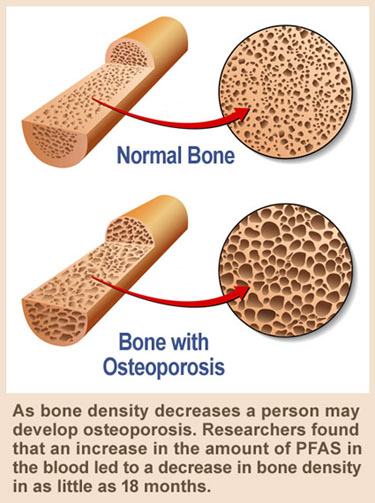Low bone density is a health concern usually relegated to the realm of the middle-aged and elderly.
Doctors are unlikely to discuss it with younger patients, unless there’s some related health concern; and coverage in magazines is limited to publications for the elderly.
However, modern environmental factors start affecting bone health a lot earlier than people realize—and now we know one of those factors is exposure to “forever chemicals.”
According to new research from the University of Southern California, exposure to forever chemicals is significantly affecting bone health in adolescents and young adults. The researchers explain that a lower bone mineral density puts a person at risk for brittle bones and other bone diseases.
Polyfluoroalkyl and perfluoroalkyl substances (abbreviated as PFAS) have earned the name “forever chemicals” because they degrade extremely slowly—if they even break down at all. These chemicals are also known as persistent organic pollutants.
PFAS–a brief history
PFAS are manufacturing chemicals that were introduced into products in the mid-20th century due to their enhanced durability properties, including water-resistantance. They are perhaps best known for being included in materials such as Teflon or aqueous film forming foam.
When PFASs were first utilized in the 1940s, they were considered inert and so minscule as to present no hazard to humans. Later, PFAS molecules were shown to accumulate in humans to such a degree that adverse health outcomes resulted. Only since the start of the 21st century has the environmental impact and toxicity to human and mammalian life been studied in depth.
In 2022 it was discovered that PFASs are now so widespread that they are ubiquitous in rainwater worldwide. So, while it is possible for a person to limit their exposure to PFASs, it is now impossible to avoid exposure entirely.
In recent decades, studies have linked high exposure to PFAS to reproductive problems, a higher risk of cancer, and other health problems.
The new study extended the existing research to PFAS-related health problems among Hispanic adolescents and young adults.
The research, conducted at University of Southern California’s Keck School of Medicine. Research was funded by National Institutes of Health, which asserts the Hispanic population has an increased risk for bone disease and osteoporosis.
Bone mineral density
To assess the affects of PFAS on test subjects researchers monitored changes in bone mineral density. Bone mineral density increases during adolescence and peaks between the ages of 20 and 30. After that, it slowly decreases for the rest of adulthood.
To determine bone mineral density a scan is performed using a process known as dual energy X-ray absorptiometry.
A loss of bone mineral density that weakens bones is known as osteopenia. It’s more common in people older than 50, especially women.
As bone mineral density decreases further a person may develop osteoporosis. Osteoporosis is a systemic skeletal disorder characterized by low bone mass, micro-architectural deterioration of bone tissue, and consequent increase in fracture risk. It is the most common reason for broken bones among the elderly.
Study details
To conduct the study the researchers tracked the bone health of 304 Hispanic adolescents with an average age of 11. The researchers took blood samples to measure PFAS levels in the body and used bone density scans to measure bone density.
After a period of 18 months, the team retested to see if there was a change over time.
The researchers discovered when the amount of perfluorooctanesulfonic acid—a type of PFAS—in the blood doubled, the test subjects had an average decrease of 0.003 g/cm2 in bone mineral density.
A separate test involved 137 young adults who underwent the same X-ray scans and blood samples for PFAS exposure at the time of the study and again four years later. A two-fold increase in baseline perfluorooctanesulfonic acid levels was associated with an average decrease of 0.032g/cm2 in bone mineral density.
The study is published in the journal Environmental Research in December 2023.
According to the researchers, the harmful effects of forever chemicals on human health should have lawmakers drawing up stricter regulations for this class of chemicals.
As with all government-funded studies, the expert recommendations centered on additional government regulations; however, the authors of the study did note that individuals “can lower their PFAS exposure risk at home by avoiding nonstick pans and personal care products containing PFAS.”
While not mentioned by the researchers, studies that highlight the detrimental affects of PFAS also highlight the fact that extra effort needs to be made to maintain critical bone density—a need that begins, as this study shows, in adolescence.
In addition to maintaining a healthy diet, getting adequate exercise, and avoiding alcohol and tobacco, supplementing critical nutrients can help. Optimal BonePlus Calcium can fill this need. Click on the banner ad on this page to learn more.
– – –
Source: Environmental Research.



